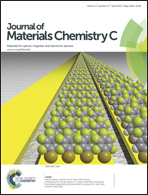Anti-Arrhenian behaviour of conductivity in octanoic acid–bis(2-ethylhexyl)amine systems: a physico-chemical study
Abstract
Pure surfactant liquids and their binary mixtures, owing to the amphiphilic nature of the molecules involved, can exhibit nano-segregation and peculiar transport properties. The structural and dynamic properties of octanoic acid (OA)–bis(2-ethylhexyl)amine (BEEA) liquid mixtures at various compositions have been studied by Wide Angle X-ray Scattering (WAXS), 1H-NMR and broadband dielectric spectroscopy as a function of temperature. It was found that the self-assembly occurs via proton exchange between the OA COOH group and the BEEA NH one; such self-assembled local structures are affected anisotropically by a temperature increase so that the thermal dilatation is more marked in a direction perpendicular to the molecular axis whereas it is practically unaffected along its axis. Interestingly, an anti-Arrhenian behaviour of the conductivity has been found at the OA molar ratio (XOA) of around 0.66. This behaviour has been interpreted as the overall result of the competition between the tendency of OA surfactant molecules to aggregate through OA–OA H-bond formation and the establishment of hetero-adducts OA–BEEA joined to the temperature disordering effect. The potentialities of such systems as proton conducting water-free organic-based liquid systems enable them to be tailored for their direct use as liquid membranes in fuel cells but also, from a more general perspective, for the piloted design of smart materials for specific applications.


 Please wait while we load your content...
Please wait while we load your content...